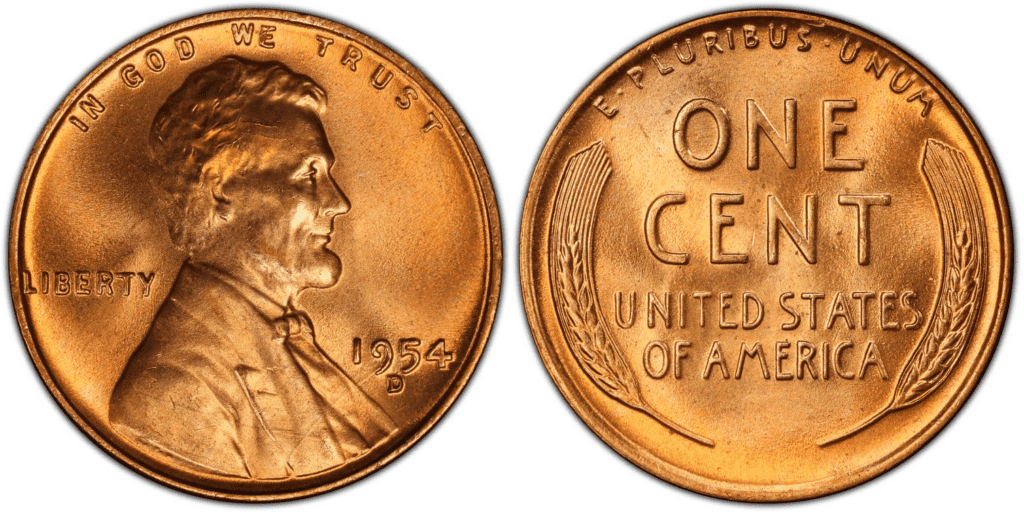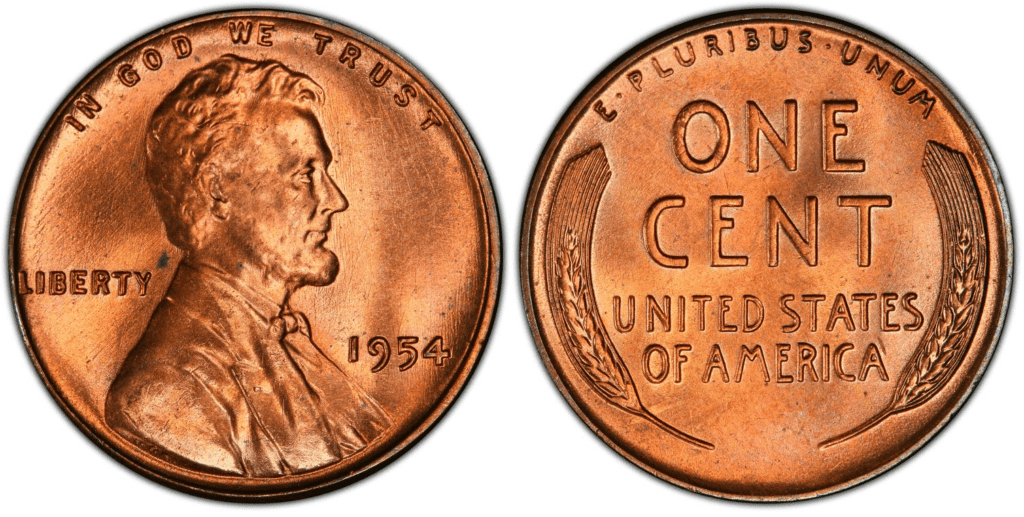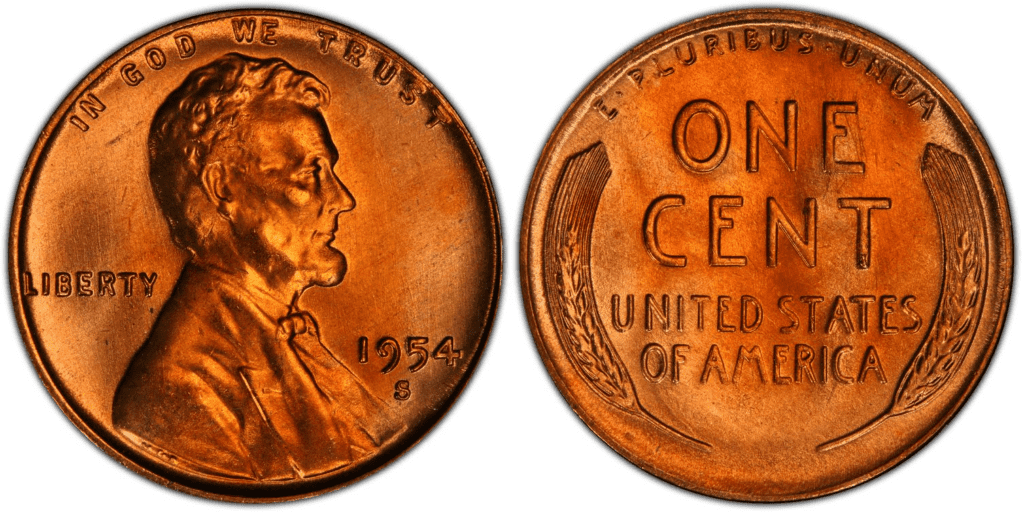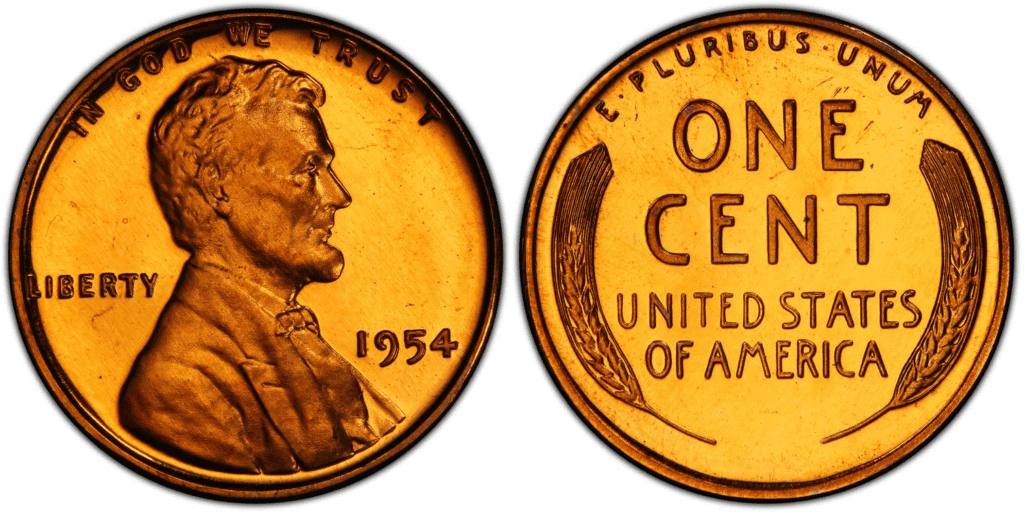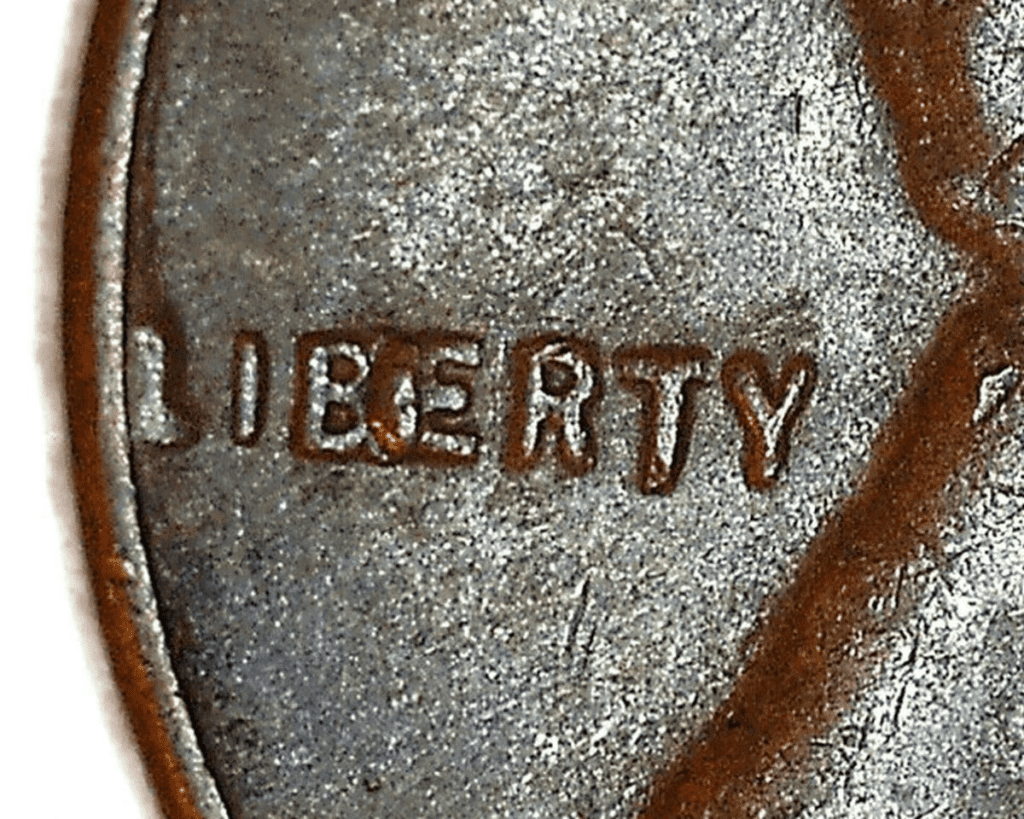What Is the 1954 Lincoln Penny Made Of?
The Lincoln penny is perhaps the most popular coin in the United States. Not just because of how much it is used in everyday life but because it has been in circulation since 1909.
The 1954 Lincoln penny is made of 95% copper and a 5% mixture of tin and zinc. The value of the penny is 1 cent. It has a mass of 3.11 grams, heavier than pennies today. However, the diameter of the coin stays the same at 19.05 mm. The edge has always been plain and not reeded.
It’s worth noting that the Lincoln penny had a different composition in various years. For example, 1943 was a unique year in terms of composition because it was the only year that the Lincoln penny was made of zinc-plated steel.
From 1909 to 1942 and from 1944 to 1982, the penny was made of 95% copper and 5% tin or zinc. Then, from 1982 to the current year, the penny is now made of 97.5% zinc and 2.5% copper.

photo source: USA Coin Book
Victor David Brenner originally designed the Lincoln penny. On the obverse, you’ll find the bust of Abraham Lincoln, the sixteenth president of the United States. Inscriptions include the following:
- IN GOD WE TRUST
- LIBERTY
- 1954
On the reverse, you’ll find two stalks of wheat on both sides of the coin. Inscriptions include the following:
- E PLURIBUS UNUM
- ONE CENT
- UNITED STATES OF AMERICA
1954 Lincoln Penny Varieties
The 1954 Lincoln penny has four standard varieties. These are 1954-P, 1954-D, 1954 proof, and 1954 S Lincoln penny. The design of these coins basically looks the same. However, they differ in their mint marks.
Aside from the standard varieties, there are also some error coins that made it to circulation.
Here are the 1954 Lincoln penny varieties that you should know:
1954 D Lincoln Penny
Edge: Plain
Mint Mark: D
Place of minting: Denver
Year of minting: 1954
Face Value: $0.01 (one cent)
Price: $0.01 to $65.00 (or more)
Quantity produced: 251,552,500
Designer: Victor D. Brenner
Composition: 95% copper and 5% tin or zinc
Mass: 3.11 grams
Diameter: 19.05 mm
Thickness: 1.52 mm

photo source: PCGS
The Denver Mint produced more than 251,552,500 1954-D pennies.The Mint produced the most number of pennies in 1954. You can buy one for about $0.01 to $65 if the coin is in circulated condition. The price can be higher if it is favorably graded.
Because of the high mintage of 1954-D pennies, they can still be seen in circulation today even if decades of years have already passed. Coins in MS64 condition can be easily found from rolls. Even coins in MS65 and MS66 should reasonably be available. On the other hand, the 1954-D becomes super scarce in MS67 conditions. There might probably be under 100 of these MS67-graded penny coins today.
1954 P Lincoln Penny
Edge: Plain
Mint Mark: None
Place of minting: Philadelphia
Year of minting: 1954
Face Value: $0.01 (one cent)
Price: $0.01 to $14.00 (or more)
Quantity produced: 71,640,050
Designer: Victor D. Brenner
Composition: 95% copper and 5% tin or zinc
Mass: 3.11 grams
Diameter: 19.05 mm
Thickness: 1.52 mm

photo source: PCGS
The Philadelphia Mint produced more than 71 million Lincoln pennies in 1954. Its price can start from $0.01 to $14.00. Rare and unique coins can be more expensive.
It’s worth noting that the mintage of the penny in 1954 drastically fell. In 1953, the Philadelphia Mint produced more than 256 million. Compare that to the 71 million in 1954.
Some numismatists noted that the 1954-P was struck poorly. This is because the Mint used worn-out dies. That’s why 1954-P pennies with a grade of MS67 are extremely rare.
1954 S Lincoln Penny
Edge: Plain
Mint Mark: No mint
Place of minting: San Francisco
Year of minting: 1954
Face Value: $0.01 (one cent)
Price: $0.01 to $20.00 (or more)
Quantity produced: 96,190,000
Designer: Victor D. Brenner
Composition: 95% copper and 5% tin or zinc
Mass: 3.11 grams
Diameter: 19.05 mm
Thickness: 1.52 mm

photo source: PCGS
The San Francisco Mint produced more than 96 million pennies in 1954. Therefore, this coin’s price may range from $0.01 to $20.
In 1954, San Francisco’s Mint produced poorly struck Lincoln 1-cent coins. Quality control wasn’t so good, and worn-out dies were used. This was the main reason that there are a lot of 1954-S pennies that look blurry.
1954 Proof Lincoln Penny
Edge: Plain
Mint Mark: None
Place of minting: Philadelphia
Year of minting: 1954
Face Value: $0.01 (one cent)
Price: $0.01 to $17.00 (or more)
Quantity produced: 233,300
Designer: Victor D. Brenner
Composition: 95% copper and 5% tin or zinc
Mass: 3.11 grams
Diameter: 19.05 mm
Thickness: 1.52 mm

photo source: PCGS
The Philadelphia Mint produced more than 233,300 Lincoln proof pennies in 1954. Its price can start from $0.01 to $17.00. Rare and unique coins can be more expensive.
As you can see, there are only more than 233 thousand proof pennies. This tells you that there was a low demand for proof coins in 1954. Nevertheless, because only a few are made, there’s also a low demand, leading to their value increasing even more.
List of 1954 Lincoln Penny Errors
With more than 419 million 1954 Lincoln pennies, it’s just a matter of time before some coins will be made with errors. Although the US Mint doesn’t want to have error coins, many coin collectors would love to have them.
As mentioned above, the pennies struck in Philadelphia and San Francisco were poorly struck. As a result, there are a lot of 1954 pennies with blurry and smudged appearances, even if they just entered circulation.
One interesting error you might want to note is the 1954 S Lincoln wheat penny “BIE” die break error. In this error, the die broke between B and E in the word “LIBERTY.”
The error looks like this:

photo source: eBay
So, there’s an extra letter I between the B and the E.
Aside from that, other errors happened during the 1954 penny-minting process. For example, some errors occurred when the planchet was being prepared. For example, the planchet becomes clipped or folded. Sometimes, the planchet didn’t get any die strike; thus, it came out of the Mint blank.
How Much Is the 1954 Lincoln Penny Worth Today?
The 1954 Lincoln penny has a face value of 1 cent. Its melt value isn’t that much, which is about $0.0253.
You might think the penny isn’t worth anything after knowing its face value and melt value. Nevertheless, don’t lose heart. Did you know there are still 1954 Lincoln wheat pennies worth hundreds and even thousands of dollars?
Take a look at this 1954 Lincoln Penny values chart to learn more about its pricing:
| Coin | Condition | Grade | Mintage | Value |
| 1954 D Lincoln penny | Circulated/Mint | Not graded | 251,552,500 | $0.012 to $0.20 |
| 1954 D Lincoln penny | Uncirculated/Mint | MS-65 | 251,552,500 | $7 to $20 |
| 1954 D Lincoln penny | Uncirculated/Mint | MS-66 | 251,552,500 | $25 to $71 |
| 1954 D Lincoln penny | Uncirculated/Mint | MS-67 | 251,552,500 | $132 to $552 |
| 1954 P Lincoln penny | Circulated/Mint | Not graded | 71,640,050 | $0.35 to $0.45
|
| 1954 P Lincoln penny | Uncirculated/Mint | MS-65 | 71,640,050 | $15 to $26 |
| 1954 P Lincoln penny | Uncirculated/Mint | MS-66 | 71,640,050 | $71 to $145 |
| 1954 P Lincoln penny | Uncirculated/Mint | MS-67 | 71,640,050 | $1,920 to $23,500 |
| 1954 Proof Lincoln penny | Circulated/proof | Not graded | 233,300 | $0.01 to $7.00 |
| 1954 Proof Lincoln penny | Uncirculated/proof | PR-67 | 233,300 | $25 to $78 |
| 1954 Proof Lincoln penny | Uncirculated/proof | PR-68 | 233,300 | $112 to $176 |
| 1954 Proof Lincoln penny | Uncirculated/proof | PR-69 | 233,300 | $432 to 1,410 |
| 1954 Proof Lincoln penny | Cameo | MS-68 | 233,300 | $504 to $2,820 |
| 1954 Proof Lincoln penny | Deep Cameo/Ultra Cameo | MS-68 | 233,300 | $1,440 to $14,920 |
| 1951 P Lincoln penny | Circulated/Mint | Not graded | 96,190,000 | $0.30 to $0.50
|
| 1954 S Lincoln penny | Uncirculated/Mint | MS-65 | 96,190,000 | $7 to $20 |
| 1954 S Lincoln penny | Uncirculated/Mint | MS-66 | 96,190,000 | $31 to $141 |
| 1954 S Lincoln penny | Uncirculated/Mint | MS-67 | 96,190,000 | $489 to $2,820 |
As you can see, some 1954 pennies are just so valuable. To get an idea of their potential value, take a look at the auction records of each of the 1954 wheat penny varieties:
- $31,200 = 1954 1C, RD (Regular Strike) with a grade of MS67RD, sold in January 2019 by Heritage Auctions
- $14,950 = 1954 1C, DCAM (Proof) with a grade of PR68, sold in May 2012 by Heritage Auctions
- $7,638 = 1954-D 1C, RD (Regular Strike) with a grade of MS67+, sold in February 2015 by Heritage Auctions
- $1,880 = 1954-S 1C, RD (Regular Strike) with a grade of MS67+ , sold in August 2013 by Heritage Auctions
How Does The Grading System Work?
The Sheldon Scale is used by numismatists to provide a numerical value to coins. The Sheldon Scale goes from poor (P-1) to perfect mint state (P-1) (MS-70). Coins were originally evaluated using words to reflect their condition (Good, Fair, Excellent, Etc.). Unfortunately, coin collectors and dealers had different ideas about what each of these terms represent.
Professional numismatists joined together in the 1970s and established CoinGrading standards. These numismatists now assign grades at key places on the seventy-point scale, using the most regularly utilized numeric points in conjunction with the original adjective grade. The following are the most common coin grades:
-
-
- (P-1) Poor – Indistinguishable and probably damaged; if used, must have a date and mintmark; otherwise, rather battered.
- (FR-2) Fair – Nearly smooth, but without the damage that a coin graded Poor often possesses. The coin must have enough detail to be identified.
- (G-4) Fair – Inscriptions have merged into the rims in some areas, and important elements have been mostly erased.
- (VG-8) Very Good- A little weathered, but all of the primary design elements are visible, albeit faintly. There is little if any, central detail left.
- (F-12) Good – The item is very worn, yet the wear is even, and the overall design details stand out clearly. Rims are almost completely isolated from the field.
- (VF-20) Very Fine – Moderately weathered, with some finer features still visible. The motto or all letters of LIBERTY are readable. Both sides of the coin have entire rims that are separated from the field.
- (EF-40) Extremely Fine – Gently used; all gadgets are visible, and the most important ones are bold. The finer details are bold and clear, however, light wear may be seen.
- (AU-50) Uncirculated – Slight evidence of wear on the coin’s design’s high points; may have contact marks; eye appeal should be adequate.
- (AU-58) Uncirculated Choice – Slight traces of wear, no severe contact marks, almost full mint shine, and great eye appeal.
- (MS-60) Mint State Basal – Strictly uncirculated; no indication of wear on the coin’s highest points, but an unsightly coin with reduced luster, visible contact marks, hairlines, and other flaws.
- (MS-63) Mint State Acceptable – Uncirculated, but with contact scratches and nicks, little reduced shine, but otherwise appealing appearance. The strike is weak to average.
- (MS-65) Mint State Choice – Uncirculated with great mint shine, very little contact blemishes, and exceptional eye appeal. The strike is unusually severe.
- (MS-68) Mint State Premium Quality – Uncirculated with superb luster, no obvious contact marks to the naked eye, and exceptional eye appeal. The strike is quick and appealing.
- (MS-69) Almost Perfect Mint State – Uncirculated with perfect brilliance, a sharp and appealing strike, and extremely good eye appeal. A near-perfect coin with minor imperfections in the planchet, strike, and contact markings (seen only under 8x magnification).
- (MS-70) Mint State Perfect – Under 8x magnification, there are no tiny imperfections discernible; the strike is crisp, and the coin is perfectly centered on a beautiful planchet. Rarely seen on a coin, this coin is bright and whole, with original luster and exceptional eye appeal.
-
Where To Buy Or Sell 1954 Lincoln Penny?
You can go to the Internet and search for the coin that you like. Use keywords like “Buying 1954 Lincoln wheat penny” or “Selling 1954 Lincoln wheat penny.” You should then instantly receive hundreds of relevant results.
If you want specific websites, then you can be sure that Amazon, eBay, and Etsy would be among the options. There are also websites that specialize in buying and selling Lincoln pennies. Examples would be JM Bullion, USA Coin Book, and CoinTrackers, to name a few.
Of course, the Internet is not the only place for you to buy or sell 1954 Lincoln 1-cent pennies. You can also go to antique shops, pawnshops, and coin shops. Try to join auctions as well.
FAQs
How rare is a penny from 1954?
The 1954 penny isn’t rare, especially if you’re looking for circulated coins. However, 1954 pennies with grades of at least MS68 or PR68 are rare since only a few of them are known to exist today.
What is the error on the 1954 D wheat penny?
The most common error of the 1954 D wheat penny would be the die break. Other errors include off-center strikes, planchet errors, and doubled die strikes.
How much is a 1954 no mint penny worth?
Circulated 1954, no mint penny would only be worth a few cents. However, if you have a 1954 no mint penny, which is still in good condition and has a rare attribute, then you can sell that for a few hundred to even a thousand bucks.


